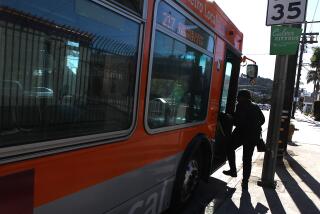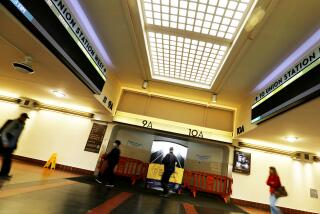L.A. bus ridership continues to fall; officials now looking to overhaul the system

L.A. officials have long said declining bus ridership was out of their control. (May 23, 2017) (Sign up for our free video newsletter here http://bit.ly/2n6VKPR)
As ridership on Southern California’s largest bus network has dropped steadily over the last few years, transportation officials have expressed confidence that the decline was temporary and riders would soon return.
The Metropolitan Transportation Authority attributed the drop to factors beyond its control, including more people buying cars, cheap gas and a recent state law that allows immigrants who are in the country illegally to obtain driver licenses.
Now, transportation officials are considering another explanation for why riders have stopped taking buses: The service isn’t good enough.
After months of preliminary research, Metro officials acknowledge that Los Angeles County’s sprawling bus system isn’t working as well for riders as it once did.
Metro bus ridership fell 18% in April compared with April 2015. The number of trips taken on Metro buses annually fell by more than 59 million, or 16%, between 2013 and 2016.
A recent survey of more than 2,000 former riders underscores the challenge Metro faces. Many passengers said buses didn’t go where they were going — or, if they did, the bus didn’t come often enough, or stopped running too early, or the trip required multiple transfers. Of those surveyed, 79% now primarily drive alone.
In an attempt to stem the declines, Metro is embarking on a study to “re-imagine” the system’s 170 lines and 15,000 stops, officials said. Researchers will consider how to better serve current riders and how to attract new customers, and will examine factors including demographics, travel patterns and employment centers.
“We’re misaligned with current travel demands,” said Conan Cheung, a senior executive officer at Metro. The agency hasn’t overhauled the bus system in more than 25 years, since the county’s first modern rail line began running between Long Beach and downtown Los Angeles, he said.
Since then, the region has added more than 100 miles of passenger rail, as well as 538 miles of commuter rail lines connecting six counties.
The results of the study, expected in April 2019, could lead to a possible overhaul of the bus network, including where buses go, what time they run and how often they arrive.
Metro, which runs the country’s second-busiest bus system, is hardly alone in its ridership losses. Cities including Phoenix, Miami and Orlando reported double-digit declines last year.
But no region is poised to invest more aggressively in transit construction than Los Angeles County, where voters recently approved a sales tax increase worth an estimated $120 billion over four decades for rail construction, bus improvements and system repairs.
High ridership on new rail lines, including a planned route through the Sepulveda Pass, will require a well-organized bus network, experts say. Buses will also continue to play an important role along busy corridors, and in neighborhoods where rail won’t be built.
Buses are still the backbone of the Metro system, accounting for about 72% of trips taken last year.
Experts have theorized that Metro has lost a relatively small number of dedicated riders, who formerly took buses for every kind of trip, including commuting and running errands. Because those passengers took multiple trips per day, their departure has had an outsized effect on overall ridership.
“The decline in ridership isn’t coming from people who use transit a few times a week who’ve shifted to Uber and Lyft,” said Juan Matute, the associate director of UCLA’s Institute of Transportation Studies.
The reason those riders have left may vary, but officials believe many of them are now driving. California’s booming economy has helped some low-income families afford a car, while a law that took effect in 2015 allows immigrants in the country illegally to apply for driver’s licenses.
Transit may take too long now because the routes have been altered, or because buses are getting stuck in traffic, Cheung said. With the rise of telecommuting, flexible shifts, and multiple part-time jobs, other riders have found that bus schedules don’t work for them.
“If you look at a two-dimensional map, it looks like we serve everyone,” Cheung said. “But you have to layer other dimensions in there. Is there enough frequency? Are we there at the hours people want to travel? Does it require several transfers to get from origin to destination?”
Every part of the county is within reach on Metro’s local buses, but they don’t come often enough, particularly in the San Fernando Valley and the South Bay, said Richard Snyder, 32, of North Hollywood.
“You have to wait half an hour, 40 minutes,” said Snyder, a video game tester who has relied on transit since he moved to Los Angeles three years ago. “You can’t live a very normal existence, especially when you consider there are quite a few places not covered by the trains.”
Infrequent stops make any trip involving an orange local bus “harder than it should be,” Snyder said. A wait of 15 minutes or longer makes other options more attractive, he said, such as walking to a rail station, or calling an Uber.
After enduring a commute from Canoga Park to Torrance that required three transfers and took two hours each way, Snyder moved to North Hollywood, within walking distance of the Metro station.
Metro will work with the 16 largest bus operators in the county on strategies to retain riders and attract new ones. Many of those carriers, including Long Beach Transit and Santa Monica’s Big Blue Bus, have also seen ridership declines.
The study will include other transportation options, including bicycle sharing and smaller, shuttle-like vans, called “micro-transit,” which can be used to carry riders from stations to their destinations.
“Transit is not a one-size-fits-all market anymore,” Cheung said. “We have to understand what people’s travel patterns are for various trips and purposes.”
Twitter: @laura_nelson
ALSO
L.A. will pay $4.5 million to the family of a cyclist killed in an Eagle Rock crash
Next stop for L.A. Metro: A committee focusing on what it’s like to be a rider
More to Read
Start your day right
Sign up for Essential California for news, features and recommendations from the L.A. Times and beyond in your inbox six days a week.
You may occasionally receive promotional content from the Los Angeles Times.







